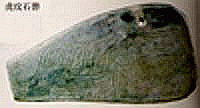 |
||||||||
Qing |
||||||||
 |
The qing is the oldest ethnic musical instrument. It is
designed finely, and carries with it an ancient flavour. In the far ancient
society when the female played the leading role (matriarchal society),
this instrument was called shi and minqiu, meaning stone and ringing ball
respectively. At that time, people lived on fishing. They enjoyed themselves
after the labour work by dressing themselves in the images of wild beasts,
dancing and knocking on the stones. |
|||||||
| The qing was first performed in the civilian music and dancing
activities. Later, like another ancient musical instrument called the
bianzhong, it was used to play some graceful music when the ancient governors
sent troops for wars and offered sacrifices. In terms of where and how it was performed, the instrument is divided into two groups. One was performed when the emperors held a memorial ceremony for the god and ancestors. The other, called bianqing, was used in royal music performance. Bian here means being bound together, in which a number of qing are grouped together and hung onto the wooden frames. During the Warring States Period (475-221BC), the making craftwork of the Chu state reached a relatively high level. In August 1978, a royal tomb of more than 2,400 years was discovered in Central China's Hubei Province. More than a 120 pieces of instruments and cultural relics were dug out from the tomb. There were altogether 32 qing pieces, which were hung in upper and lower lines. They were made of limestone, bluestone, and boulder. The sound was bright and clear. It was a pity that most of them were broken, and so cannot produce any sound. In 1980, the museum of Hubei Province and the Wuhan Institute of Physics worked together to duplicate those instruments found in the tomb. The sounds produced by the new were basically the same as the original ones. The tones were moving and graceful. In 1983, the Dance and Sing Ensemble of Hubei Province created a set of stone-made bianqing with 32 single pieces. In September 1984, an ethnic instrument-designing factory and a boulder sculpture mill in East China's Suzhou again developed a set of bianqing with 18 single pieces. |
||||||||
|
||||||||